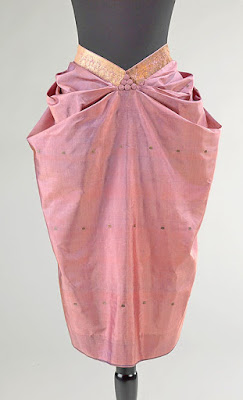Mainbocher (1890-1976) American
 |
| Image in Vogue, 1953. |
Born Main Rousseau Bocher in Chicago, after serving in World War I, he decided to remain in Europe. His career in fashion began in 1922 when he worked as an illustrator for Harper’s Bazaar. Later he moved to Vogue, working there from 1923-1929 as a fashion editor and eventually became editor-in-chief of the French edition of Vogue. In 1929, when he opened his Paris couture salon, he chose to combine his first and last names to become Mainbocher, in a move that could be seen as trying to fit in as an American in Paris.
 |
| "Mainbocher corset" by Horst B. Horst, 1939. |
Mainbocher was known as a creator of expensive clothes that exhibited discretion, simplicity, and understatement. His garments were uncomplicated and unadorned but still quite chic.
 |
| Silk evening dress, 1938. |
Elegant evening gowns were one of his specialties, designed as high-waisted, long ball gowns of lace or transparent fabrics. He also was known for his tweed dinner suits paired with delicate blouses.
It may be said that some of his daytime designs before the war, which were enhanced by the wearing of corsets, were precursors of Dior’s “New Look.” An example of this corset was even immortalized in the famous Horst P. Horst photograph from 1939 entitled “Mainbocher Corset,” shown above.
 |
| Silk crepe evening jacket, 1937. |
 |
| Jacket worn by Wallis. |
He was well known as a favorite couturier of Wallis Simpson, the Duchess of Windsor in part because his designs seemed to speak to her somewhat prudish type of elegance. In fact, she was his most important client and he created detailed design books for her filled with his colored sketches and fabric swatches.
 |
| Duke and Duchess of Windsor wedding day. |
Most famously he designed her unique 1937 wedding gown in “Wallis Blue”, a pale grayish blue custom color created specifically for her. The dress and its design elements have been frequently copied because of the fashion icon the Duchess became throughout her life.
 |
| Wallis Windsor wedding dress, 1937. |
Unfortunately, the dress was inappropriately dyed and in time has faded from pale blue to a pinkish beige.
 |
| Silk gown, 1933. |
His philosophy was, “The responsibility and challenge…is to consider the design and the woman at the same time. Women should look beautiful, rather than just [trendy] trendful.” Another saying of his was that “wearability is half the secret of good clothes.”
 |
| Silk apron skirt, 1939. |
Mainbocher closed his Paris salon in 1939, reopening it in New York in 1940. During that time, he designed costumes for numerous Broadway theater productions such as Blithe Spirit and The Sound of Music. In 1971, he eventually retired from the business at the age of eighty-one.
 |
| McCall 6984. |
Home Sewing Connection: Mainbocher created a few designs for the McCall Pattern company.
 |
| Silk gown, 1947. |
His style, innovations, and influence on fashion:
 |
| Satin gown, 1949. |
- Details he used in his designs were gigot sleeves, ruffles, and trains.
- He liked to contrast the formality of garments with casual fabrics. Some of the fabrics he used in his work were men’s shirting, linen toweling, cotton pique, and pastel gingham.
- Mainbocher designed uniforms for the WAVES organization and the American Red Cross.
- Embroidered and beaded cashmere evening sweaters with jeweled buttons were his specialty.
- Mainbocher never allowed the licensing of his name or work except for use as sewing patterns.
Sources: The Way She Looks Tonight (1996) Marian Fowler; Contemporary Fashion (1995) Therese Duzinkiewicz Baker; Fashion: The Century of the Designer, 1900-1999 (1999) Charlotte Seeling.
No comments:
Post a Comment